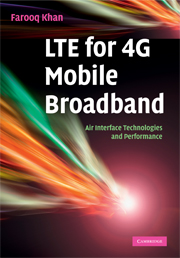Book contents
- Frontmatter
- Contents
- Preface
- 1 Introduction
- 2 Network architecture and protocols
- 3 Downlink access
- 4 Single-carrier FDMA
- 5 Reducing uplink signal peakiness
- 6 Transmit diversity
- 7 MIMO spatial multiplexing
- 8 Channel structure and bandwidths
- 9 Cell search and reference signals
- 10 Random access
- 11 Channel coding
- 12 Scheduling, link adaptation and hybrid ARQ
- 13 Power control
- 14 Uplink control signaling
- 15 Downlink control signaling
- 16 Inter-cell interference control
- 17 Single frequency network broadcast
- 18 Spatial channel model
- 19 LTE performance verification
- Index
1 - Introduction
Published online by Cambridge University Press: 28 February 2011
- Frontmatter
- Contents
- Preface
- 1 Introduction
- 2 Network architecture and protocols
- 3 Downlink access
- 4 Single-carrier FDMA
- 5 Reducing uplink signal peakiness
- 6 Transmit diversity
- 7 MIMO spatial multiplexing
- 8 Channel structure and bandwidths
- 9 Cell search and reference signals
- 10 Random access
- 11 Channel coding
- 12 Scheduling, link adaptation and hybrid ARQ
- 13 Power control
- 14 Uplink control signaling
- 15 Downlink control signaling
- 16 Inter-cell interference control
- 17 Single frequency network broadcast
- 18 Spatial channel model
- 19 LTE performance verification
- Index
Summary
The cellular wireless communications industry witnessed tremendous growth in the past decade with over four billion wireless subscribers worldwide. The first generation (1G) analog cellular systems supported voice communication with limited roaming. The second generation (2G) digital systems promised higher capacity and better voice quality than did their analog counterparts. Moreover, roaming became more prevalent thanks to fewer standards and common spectrum allocations across countries particularly in Europe. The two widely deployed second-generation (2G) cellular systems are GSM (global system for mobile communications) and CDMA (code division multiple access). As for the 1G analog systems, 2G systems were primarily designed to support voice communication. In later releases of these standards, capabilities were introduced to support data transmission. However, the data rates were generally lower than that supported by dial-up connections. The ITU-R initiative on IMT-2000 (international mobile telecommunications 2000) paved the way for evolution to 3G. A set of requirements such as a peak data rate of 2 Mb/s and support for vehicular mobility were published under IMT-2000 initiative. Both the GSM and CDMA camps formed their own separate 3G partnership projects (3GPP and 3GPP2, respectively) to develop IMT-2000 compliant standards based on the CDMA technology. The 3G standard in 3GPPis referred to as wideband CDMA(WCDMA) because it uses a larger 5 MHz bandwidth relative to 1.25 MHz bandwidth used in 3GPP2's cdma2000 system. The 3GPP2 also developed a 5 MHz version supporting three 1.25 MHz subcarriers referred to as cdma2000-3x.
- Type
- Chapter
- Information
- LTE for 4G Mobile BroadbandAir Interface Technologies and Performance, pp. 1 - 4Publisher: Cambridge University PressPrint publication year: 2009

